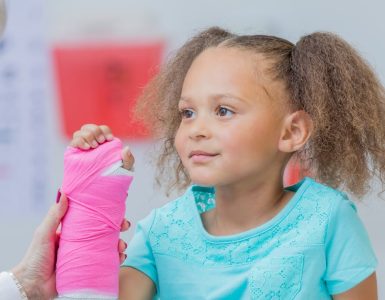August is Children’s Eye Health and Safety Month, an opportunity to raise awareness of the importance of healthy vision in children. There are a number of things parents and caregivers can do to help protect children’s eyesight as well as identify potential issues that may cause problems later on.
Stay on top of your child’s eye health by making sure they have their eyes examined on a regular basis during pediatric well visits, in addition to exams by an eye-care professional at ages 6 months, 3 years and before first grade, as well as every other year thereafter. Visit the American Optometric Association website for more information on the recommended frequency of eye exams for children.
According to Prevent Blindness America, eye injuries are the leading cause of vision loss in children. The large majority of these injuries happen during sports, so it’s critical to take precautions when your children are engaged in sports or other outdoor activities. Prevention goes a long way in keeping your child’s eyes safe. A few tips to consider include:
- Make sure children wear appropriate eye protection when playing baseball, basketball, soccer, hockey, paintball and similar activities
- Do not allow children near fireworks of any kind
- Avoid toys with sharp pieces or those that fire projectiles, including darts or similar items
- Use age-appropriate car safety seats and secure any loose items to further protect your child in case of an accident
- Supervise use of items that could cause potential harm
- Balance time spent reading or viewing screens with time outdoors
- Encourage kids to wear UV-blocking sunglasses and hats when spending time in the sun
While visiting an eye care professional is recommended and the best way to quickly identify any potential vision problems that your child may have, there are also a few indicators parents and caregivers can look for that may point to an issue. If you notice any of these signs, contact your child’s eye care provider as soon as possible:
- Eye inflammation, swelling, discharge or redness
- Eyes are misaligned or crossed
- Child rubs, squints, closes or covers one or both eyes frequently
- Trouble reading or doing work up close
- Child has headaches or feels sick or dizzy after reading or doing work up close
Keeping your child’s eyes healthy and safe now will help ensure they have great vision for years to come.
For Health Advocate Members
If you’re a Health Advocate member, call your Personal Health Advocate for help scheduling an eye exam for your child (and for yourself as well!).
Other Helpful Resources
To learn more, please visit any of the websites below that provide additional information about children’s eye health and safety:




[…] From the Health Advocate blog, get tips to help your kids protect their peepers […]
[…] Original Source: http://blog.healthadvocate.com/2014/08/protect-those-peepers-eye-safety-tips-for-kids/ […]
[…] it’s important to wear protective gear to prevent injuries. This is also important if you or your kids play sports. Just as important is to wear sunglasses when outside or driving in your car to prevent glare and […]